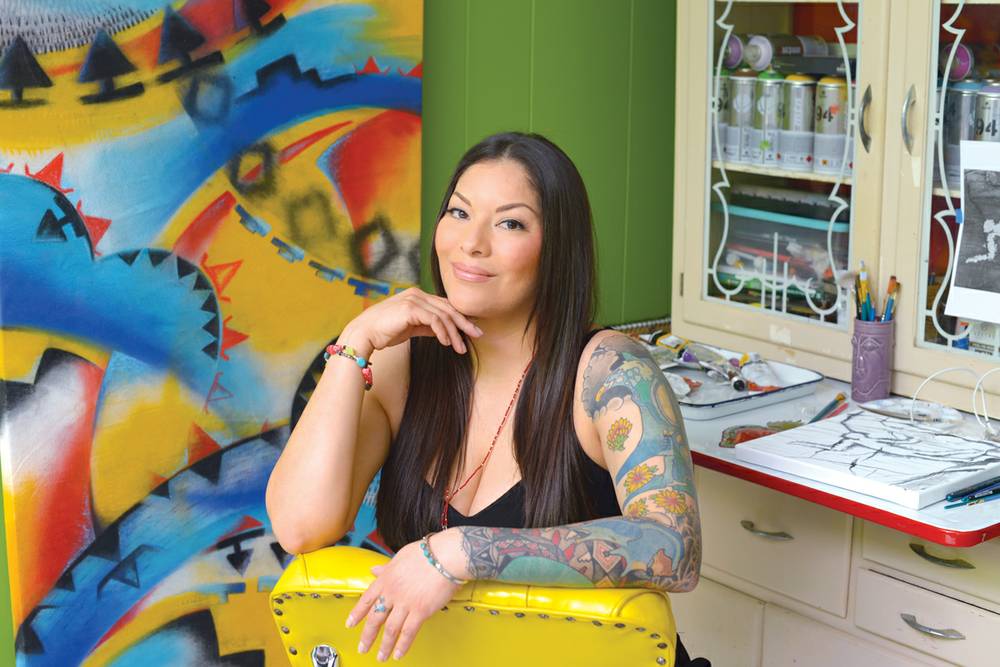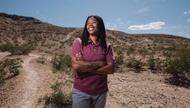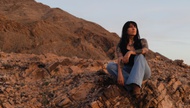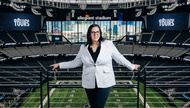Sipping an avocado smoothie at Tiabi Coffee & Waffle on Maryland Parkway, Fawn Douglas discusses ongoing damage to the petroglyphs in unprotected Gold Butte. Wearing a T-shirt that reads “Made in Native America,” the 30-something artist and activist says she is disgusted that people are using the ancient art for target practice, and makes it a point to take Native youth to the area to expose them to the importance of preservation.
Douglas lives and celebrates her heritage in her daily life and art. Now living in the retro-hip Paradise Palms neighborhood, she grew up in the Downtown colony of the Las Vegas Paiute Tribe, and stays connected by mentoring Native youth in activism and culture, whether it’s starting a tribal arts and recreation program or advocating to change Columbus Day.
Having just earned her B.A. from UNLV, Douglas heads this summer to the international artist residency Arquetopia in Mexico, where she’ll learn pigment making from natural materials. Her art is Native American contemporary, but the pigments will help in her quest to revive the tribal tradition of basket making. She recently visited her family’s heirlooms at Overton’s Lost City Museum.
The two-time Little Miss Paiute and tribal council alum has been doing Native dance since childhood and helped organize the Native American Student Association’s powwow coming up at UNLV on January 9. We spoke with Douglas, who in addition to connecting past with present, strives to make Natives more visible in contemporary society.
What motivated you to visit your family’s artifacts at the Lost City Museum? Personal research. I’d been wanting to learn how to make baskets. My people are known for it. There are no members of the Las Vegas Paiute Tribe that currently do it, and this is something I will not be able to learn in school. I viewed my great-grandmother Topsy Swains’ collection and her mother’s baskets.
How did the artifacts arrive at the museum? Various ways. One of the smaller baskets made by Topsy Swain was purchased by Dr. William S. Park in 1935. It was acquired by Iola and R.F. Perkins after his death in 1946. It was then acquired by the State of Nevada from R.F. Perkins in 1973.
What was it like to see them? It took me back to a simple time. I loved [Topsy]; she was the sweetest lady. I guess there is a part of my culture I long for. I don’t want that to go away. I want to bring it back to the youth. It’s important to be reminded what makes you special, different. We are a small tribe. Our culture is special and we are significant to this region.
Why did the basket-making tradition disappear among Las Vegas Paiutes? I have relatives that still do it from Moapa Paiute Tribe. Willows for making the baskets grow along the river there. The willows don’t grow here. Maybe that has something to do with it. My uncle Estes lives in Arizona. I asked him last year about making baskets, and he told me his wife Hopper makes them. I can learn from her. I am hoping to visit soon. There’s a certain time when the willows are grown.
How would you describe Downtown’s Paiute colony? Chill. I haven’t lived there since I was a kid. I go back frequently, though, to visit family and do events at our multi-purpose [center]. It looks the same, feels the same. I like how it’s all families that live in three cul-de-sacs that make up the colony. You can walk up or down the hill and everyone is connected. That togetherness is something I can appreciate now, but took for granted growing up there.
What are common misconceptions about Native people? That we are a thing of the past, don’t exist anymore. A lot of people don’t know we’re here. In the schools, Native American people are talked about in a past tense.
What have you learned from mentoring youth about celebrating their heritage? Supporting youth and pushing for them to be proud of their heritage is important. It’s what makes them special. That identity is so important to them. They are the strongest voices against being called “redskins,” among other racist terms. They are supportive over environmental protection and are actually the strength behind me. I wouldn’t have stepped up without the strength of their voices.
What will you be learning at Arquetopia? I want to learn about the techniques for creating natural pigments from Oaxaca and apply it. There are Paiute techniques for making different colors from desert flowers and roots. I am so fascinated how other cultures produce their colors. We might have many similarities as indigenous peoples’. I look forward to learning what that is.
UNLV Native American Student Association Social Powow January 9, 6-10 p.m., free. Student Union Ballroom, [email protected].







